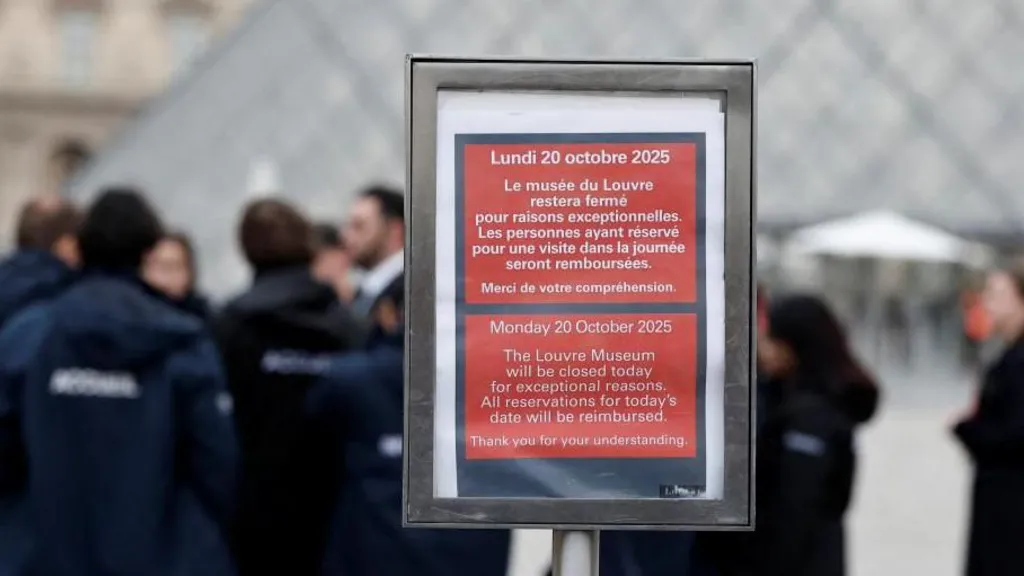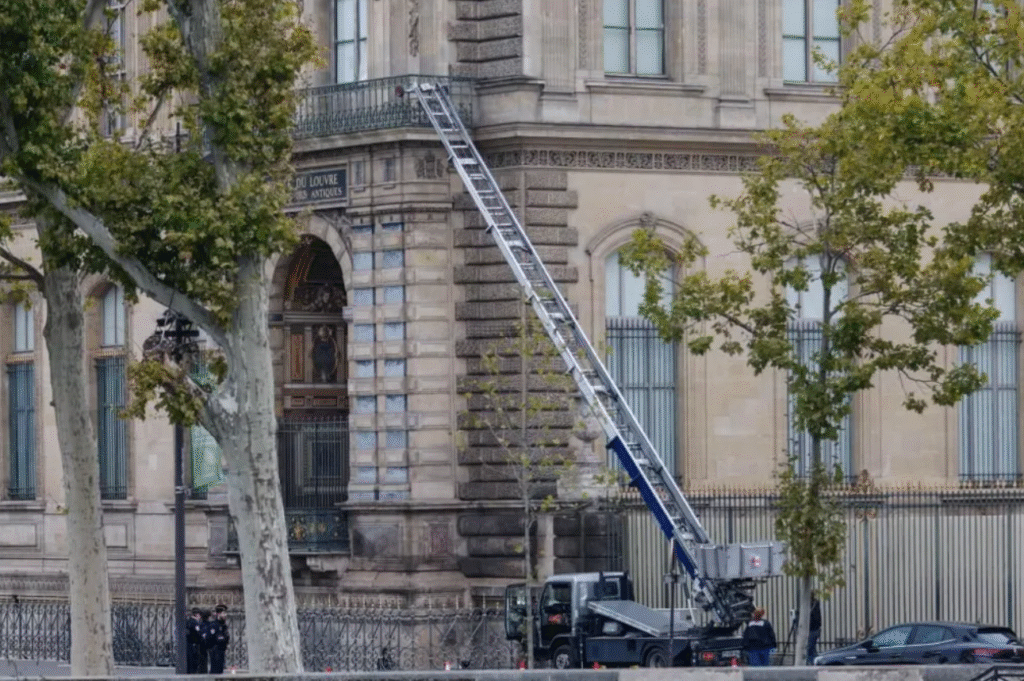The newly released Louvre heist investigation report has shocked France and the global art community, revealing an alarming breakdown in security that led to the theft of priceless royal jewelry from the world’s most-visited museum. French Justice Minister Gérald Darmanin publicly admitted that the nation’s security systems had “failed,” leaving the country with what he called “a terrible image.”
The daring robbery took place in broad daylight on Sunday morning, when masked thieves used a truck-mounted lift to break into the Louvre Museum in Paris. Within eight minutes, they made off with eight historic pieces of jewelry, including a diamond-and-emerald necklace once gifted by Emperor Napoleon to his wife, Empress Marie Louise.

Louvre Heist Investigation Report Confirms Sophisticated Planning
According to the Louvre heist investigation report, the thieves displayed an extraordinary level of coordination and professionalism. They arrived in a specially equipped vehicle, used industrial power tools to slice through glass panes, and entered the museum’s prestigious Galerie d’Apollon, where France’s royal jewels are displayed.
The entire operation lasted less than ten minutes. The gang threatened museum guards, smashed open display cases, and escaped on scooters waiting by the River Seine. They also attempted to burn their getaway truck to destroy evidence but were stopped by quick-thinking staff.
Officials confirmed that the stolen artifacts included a silver crown encrusted with diamonds and blue emeralds, a diadem once worn by Empress Eugénie, and an elaborate sapphire-and-diamond necklace belonging to Queen Marie-Amélie.
Major Gaps Exposed in Louvre Security
The Louvre heist investigation report revealed a stunning lack of surveillance and maintenance within the museum’s historic wings. A third of the rooms in the affected area reportedly had no functioning cameras, according to a preliminary assessment by the French Court of Auditors.
To make matters worse, it has been alleged that one of the gallery’s alarms was out of order, and investigators are still trying to determine whether it was disabled during the robbery. Justice Minister Darmanin expressed frustration, saying,
“People were able to park a furniture hoist in the middle of Paris, lift thieves up several meters, and steal priceless jewels, that means we failed.”
Experts Warn of Imminent Danger to Stolen Jewels
Art crime specialists are racing against time. Chris Marinello, CEO of Art Recovery International, warned that if the culprits aren’t caught within 48 hours, the jewels will likely be lost forever.
“They are not going to keep them intact,” Marinello told the BBC. “They’ll melt down the metals, recut the diamonds, and erase any trace of their crime.”
This means that while police may eventually capture the thieves, the Louvre heist investigation report suggests recovering the original artifacts will be nearly impossible once they’re dismantled or sold on the black market.
France’s Government Responds to the Louvre Heist
In the wake of the report, French President Emmanuel Macron called the theft “an attack on our national heritage,” emphasizing that these items represented centuries of history.
Interior Minister Laurent Nuñez acknowledged “a great vulnerability” in France’s museum security network, while promising that all cultural institutions will now undergo enhanced surveillance and protection measures.
Nathalie Goulet, a member of the French Senate, described the robbery as “very painful” and “deeply embarrassing.” She told BBC Radio 4 that the jewels’ theft highlighted years of underfunding in cultural security.
“We are all disappointed and angry,” she said. “It’s difficult to understand how something like this could happen so easily.”
Louvre Heist Investigation Report Points to Organised Crime
Investigators believe the heist was executed by a professional organized crime syndicate rather than amateurs. The thieves’ precision and planning indicate prior knowledge of the museum’s layout and its vulnerabilities.
According to the Louvre heist investigation report, the robbers likely had inside information, including security shift timings and structural weaknesses, allowing them to move quickly and avoid capture.
Experts warn that the jewels could be used in money laundering operations, broken into smaller components to conceal their origin. Goulet stated,
“They don’t appreciate jewelry as history; they see it as currency. This is organized crime, not passion.”
Eight Priceless Pieces Still Missing
The stolen collection includes eight historically significant items, each tied to France’s royal and imperial legacy. Among them:
-
Napoleon’s emerald and diamond necklace, gifted to Empress Marie Louise.
-
A diadem belonging to Empress Eugénie, containing nearly 2,000 diamonds.
-
A sapphire necklace worn by Queen Marie-Amélie, adorned with over 600 diamonds.
-
A silver crown with blue emeralds, once displayed in the Galerie d’Apollon.
French authorities have released photos of the missing artifacts and urged the public and international art dealers to report any suspicious sales or online listings.
Louvre Temporarily Closed Amid Ongoing Investigation
Following the robbery, the Louvre Museum closed its doors on Monday “for exceptional reasons,” allowing forensic teams to gather evidence. The museum’s management has pledged full cooperation with law enforcement and expressed deep regret over the incident.
This marks one of the most serious breaches in the Louvre’s modern history. The theft has not only damaged France’s reputation for cultural preservation but also raised fears that similar institutions could be at risk.
Authorities have vowed to strengthen surveillance systems, improve alarm functionality, and require regular safety audits across all French museums.

What Happens Next in the Louvre Heist Investigation
The Louvre heist investigation report emphasizes that the probe remains ongoing, and officials have warned against jumping to conclusions about who might be responsible. Police are analyzing video footage from nearby streets and riverbanks, hoping to trace the suspects’ escape route.
Interpol has also been alerted, as investigators suspect that the jewels could already be en route to international buyers. French law enforcement is coordinating with Europol and art-crime task forces to track smuggling networks that specialize in high-value artifacts.
Despite the grim outlook, Justice Minister Darmanin expressed confidence that the culprits will eventually be caught. “It may take time,” he said, “but justice will prevail.”

